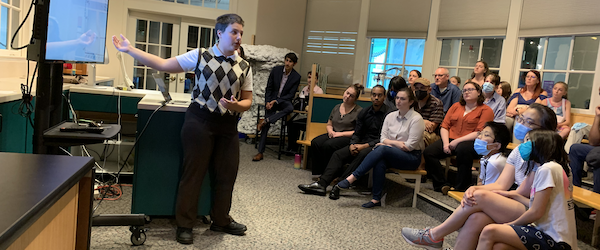2022 CDSA Research Projects : video
Variations in Mass Accretion in a Massive X-Ray Binary System
Binary systems consisting of an OB supergiant star and a compact companion can produce X-ray emissions when mass from the stellar wind of the supergiant is accreted onto the compact companion. These systems are called high mass X-ray binaries (HMXBs). In these systems, the X-ray emissions from the compact object can heat ionize the stellar wind from the OB supergiant, stopping it from being accelerated. This creates a slower wind that produces a higher mass accretion rate and therefore higher X-ray luminosity. This continues until the X-ray luminosity is high enough to cut off the solar wind, causing the mass accretion and X-ray luminosity to drop. This cycle could create a variable mass accretion rate. I use hydrodynamic simulations to model the HMXB system Vela X-1 in 2 and 3 dimensions to observe the rate at which mass is accreted onto the neutron star in the system over a period of time. I use the hydrodynamic models to find if there are any stable states in the mass accretion rate and under what conditions those stable states might occur.
Modeling Pair Instability Supernovae: from Explosion to Remnant
Pair-instability supernovae (PISNe) are a type of supernova theorized to occur at the end of the life of very massive stars (VMS) at low metallicities. Although no PISN have been observed to date, their existence is strongly suggested through simulations and theory. Additionally, several VMS that are potential PISN progenitors are known, and there are observations of unusual superluminous supernovae that are hypothesized to have originated from the PISN mechanism. Using the VH-1 hydrodynamics code, we evolve PISN simulations in one and three dimensions from explosion well into its supernova remnant stage. With these simulations we aim to obtain an understanding of what the supernova remnant (SNR) of a PISN might look like, and to compare our results with observations of potential SNRs of PISNe. We aim for this model to make a step on the path leading from modeling to observations.
Producing jets in supernova remnants through variations in the circumstellar medium
In 2004 the Chandra X-Ray Observatory captured a one-million-second view of Cassiopeia A (Cas A), the supernova remnant (SNR) of a Type IIb supernova. It revealed a jet of ejecta in the Northeast and a counter jet in the Southwest direction. Both are rich in silicon with evidence of iron, sulfur, argon, calcium, and potassium. Since this observation, there has been speculation that the jets resulted from an asymmetrical explosion rather than variation in the circumstellar medium (CSM) density. We use the VH-1 hydrodynamic code to create 2D and 3D simulations of supernovae to explore the hypothesis that the observed jet-like features arise from the interaction of a symmetrical explosion with an asymmetric CSM. In the models, CSM density is dependent on the azimuthal angle, with higher density regions near the equatorial plane and lower density regions near the poles. Tracers in the simulations track the elements from the progenitor star through the explosion. The resulting element distribution is compared to the Cas A observations. Finally, we use velocity profiles to illustrate that the ejecta had been decelerated by the reverse shock and then reaccelerated in the area between the shock waves where there is both high temperature and pressure. We also explore the relationship between the density profile and the likelihood of jets.
Multi-angle neutrino flavor transformation in supernovae
Neutrinos are an integral part of supernova explosions and their properties impact the explosion itself and the remnants created in their aftermath. By exploiting this dependence upon the neutrino, we can explore the possibility that Beyond the Standard Model neutrino physics might alter the explosion and the signal we receive. Using the multi-angle code SQA, we study the sensitivity of supernovae to Non-Standard Interactions (NSI) of neutrinos with matter. Previous studies of NSI effects have adopted the single-angle approximation. As part of this project we will compare the multi-angle calculations to the single-angle calculations to evaluate the validity of those previous studies. The flavor-transformed neutrino spectra will be processed using SNEWPY to examine whether current or near-future neutrino detectors may be sensitive to (or constrain) the NSI.
Studying the Nuclear Outflow of the Milky Way through UV absorption
The goal of this project is to compare numerical biconical outflow models with observations to infer the outflow deceleration profile and mass outflow rates from the Galactic Center.
The Galactic Center at the heart of the Milky Way is driving a nuclear wind that can be seen as a giant structure of plasma extending for 10kpc on either side of the Galactic Center [1]. These structures are called the Fermi Bubbles and they trace an explosive event from the heart of the Milky Way a few Myrs ago. Outflowing gas is visible in enhanced emission in many parts of the electromagnetic spectrum, including Fermi gamma-ray bubbles and radio lobes extending above and below the Galactic Center. We are currently pursuing a campaign to map the kinematics and extent of this nuclear outflow, using UV spectroscopy from Hubble Space Telescope [2, 3, 4]. New data is being collected, and an undergraduate student will analyze the UV spectra of background AGN and halo-stars lying close on the sky to the Galactic Center. Any variation in absorption properties with Galactic latitude will allow us to constrain the physical conditions in the outflowing gas. The participant will learn to analyze UV spectroscopy from Hubble and will learn to use Python programs to quantify the measurements. The undergraduate students will learn to code and use simple numerical biconical outflow models to interpret these observations in terms of the geometry of the gas flow.




